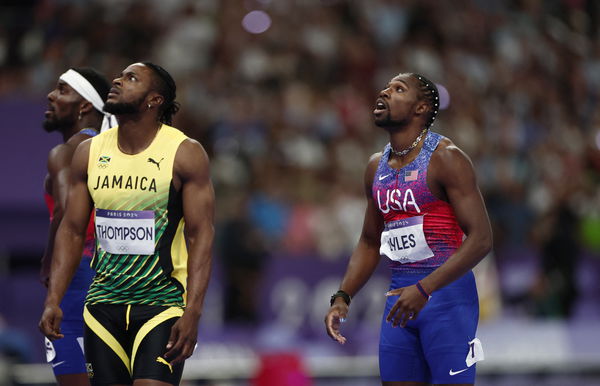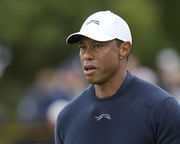
Imago
Credits: IMAGO

Imago
Credits: IMAGO
When Usain Bolt sprinted across the finish line in Beijing in 2008, he did more than secure a gold medal. He won the 200 meters by 0.66 seconds, a margin that remains extraordinary for such a short race. That summer and the years that followed left the impression that one man could bend the sport to his will, lowering world records to 9.58 seconds in the 100 and 19.19 seconds in the 200 by 2009 at the World Championships in Germany. Those performances still stand today, fixed markers of a period that looked singular in athletics history.
Watch What’s Trending Now!
Sixteen years later, the landscape is not the same. At the Paris Olympics in 2024, every man in the 100-meter final finished under 10 seconds. That had never happened before, and it revealed a field where parity has replaced hierarchy. The story is no longer about one figure rewriting the boundaries, but about an event that produces tighter margins, greater uncertainty, and a wider pool of possible winners.
The comparison between Bolt’s period and the present can be studied through several lenses. Starting from the scale of dominance, the level of competition, the stability of coaching relationships, to the management of injury and travel demands. Track expert Rori Dunk observed, “What happened to the 1-2 double? The 2 sprinter powerhouses, Jamaica and the U.S., will be sending 23 athletes to compete in the 100m or 200m at the World Championships. Out of those 23 athletes, only 4 of them will compete in both events. It used to be an expectation.” The decline of the sprint double is emblematic of a broader change, where specialization has replaced the wide-ranging dominance that Bolt once embodied.
ADVERTISEMENT
Today, athletes face highly specialized competitors in each individual event, with every finalist capable of running world-class times. The concentration of talent across the board means that attempting a double in both the 100m and 200m exposes an athlete to compounded risk. Balancing the physiological and mental demands of two events at the highest level increases the probability of underperformance in one or both races. The combination of deeper fields, precise specialization, and the intensified schedule has transformed the 1-2 double from an expectation into a rarity, highlighting how contemporary sprinting favors focused mastery over multi-event dominance.
Performance dominance is the first distinction.
Bolt was not merely winning; he was separating himself from his rivals by margins that were once thought impossible. In 2008 and 2009, his victories arrived with tenths of a second to spare, a cushion that allowed him to celebrate before the line. By contrast, today’s finals are decided by hundredths. The field in Paris during the 100m and 200m dash demonstrated that modern sprinting offers little space for such margins, and therefore little chance for one man to appear untouchable. It even raised questions about whether Kishane Thompson lost to Noah Lyles, as he did not dip during the finish. “Dipping isn’t really the key to winning a race. If you’re strong from 0 to 100 meters and can separate yourself from the pack, you don’t need to dip—simple as that,” shared Kishane Thompson after Paris.
ADVERTISEMENT
What happened to the 1-2 double? 🤔🤨
The 2 sprinter powerhouses, Jamaica and the U.S., will be sending 23 athletes to compete in the 100m or 200m at the World Championships.
Out of those 23 athletes, only 4 of them will compete in both events. 😕
It used to be an expectation pic.twitter.com/IHMyuPEUDx
— RoriDunk (@FitzDunk) September 1, 2025
Competitive depth is the natural counterpart.
ADVERTISEMENT
During Bolt’s reign, two or three men in each final posed a genuine threat. Now, five to seven runners often arrive with realistic medal ambitions. The broader spread of nations in the finals reinforces the point. Where sprinting once concentrated around Jamaica, the United States, and a handful of others, the distribution of talent is now wider. This deeper pool makes repeat triumphs harder to sustain.
Coaching stability formed another pillar of Bolt’s success.
He spent his career under the guidance of Glen Mills in Jamaica, a relationship that allowed for long-term planning and careful management of his training cycle. Today, elite athletes more often shift between groups, change geography, or alter staff composition. That movement dilutes continuity and increases the challenge of maintaining form over successive championships. Track expert Anderson Emerole pointed out, “athlete as an individual they may feel like they’re not making progress like they would expect to or they’re not meeting the goals that they set right they’re not seeing the success that they would have thought they’d achieve at a certain point” as the reason behind athletes switching coaches frequently in his ‘Final Leg Track and Field’ Podcast.
ADVERTISEMENT
Noah Lyles’ current coach, Lance Brauman, the head coach and founder of PURE Athletics, who was formerly Tyson Gay’s coach, has been a mentor who has historically trained athletes to compete relentlessly in both sprint doubles, demonstrating that some coaching philosophies still emphasize versatility across 100m and 200m events.
The calendar itself has changed, too.
The Diamond League has expanded into a global series, with obligations to appear across continents. New professional circuits, such as Grand Slam Track, add commercial incentive but also impose further commitments. In Bolt’s time, the star could restrict appearances and preserve his form for the major championships. Present athletes often face a denser program that requires sustained racing rather than selective peaks.
ADVERTISEMENT
Additionally, the scheduling of events like the 100m and 200m rounds close together at major championships, such as the World Championships and Olympics, has made recovery between events more difficult. This compressed schedule, combined with the differing training demands for each event, has led athletes to specialize in one event rather than attempting the 1-2 double. In the World Championship too, the 100m heat, 200m heat, 100m, and the 200m final are scheduled almost back-to-back in consecutive order without much gap.

Reuters
Paris 2024 Olympics – Athletics – Men’s 100m Final – Stade de France, Saint-Denis, France – August 04, 2024. Noah Lyles of United States and Kishane Thompson of Jamaica look to the screen for the final score decision. REUTERS/Gonzalo Fuentes
Adding to that, injury and travel management also weigh heavily.
ADVERTISEMENT
Modern sports medicine research shows that sprinters face frequent hamstring strains and other time-loss injuries. With a more compressed competition schedule and more intercontinental travel, coaches often prefer conservative load management. This scientific caution protects careers but reduces the likelihood of seeing the same athlete dominate with maximum output year after year.
The result is a sport with different characteristics. Bolt’s era was defined by the presence of a singular outlier whose marks remain untouched. The current period is defined by depth, international spread, and parity at the top. The change is not a decline in quality but an alteration in structure. The drama no longer rests in watching one man break free. It lies in the uncertainty of knowing that on any given night, nearly every finalist could leave with gold.
Now, reports are unraveling how advanced footwear technology spikes have altered sprint acceleration and raised both performance gains and controversy.
ADVERTISEMENT
Do super spikes indeed hold the key to faster sprints and shattered records?
At the heart of sprinting performance, a new variable had begun to shape results. The arrival of advanced footwear technology in track spikes. Once confined to distance running, the innovation found its way into the explosive world of sprinting, altering both acceleration profiles and the conversation around fairness in athletics. The question that lingered, particularly since the Tokyo Games, was whether these so-called super spikes truly conferred measurable gains or if the debate was merely one of perception.

USA Today via Reuters
Jul 20, 2024; London, United Kingdom; The New Balance FuelCell MD-X spikes worn by Gabrielle Thomas aka Gabby Thomas (USA) in the women’s 200m during the London Athletics Meet at London Stadium. Mandatory Credit: Kirby Lee-USA TODAY Sports
Evidence suggested that the gains were real.
ADVERTISEMENT
In a controlled multiple N-of-1 trial involving regional and national-level sprinters, athletes who ran in Nike’s advanced footwear technology spikes recorded faster 30-meter times than when wearing standard spiked shoes. The improvement, though modest in absolute terms, an average of two-hundredths of a second, was underpinned by changes in velocity and horizontal force ratios, both critical markers of sprint acceleration. Researchers concluded that “a positive effect on sprint acceleration characteristics was observed when using Nike® AFT spikes, due to an increase in velocity and the horizontal ratio of force.”
Top Stories
Tiger Woods Gives Fan 1-Word Reply About PGA Tour Comeback Amid Leaked Schedule

UFC 323 Payouts: How Much Will Merab Dvalishvili, Petr Yan, Alexandre Pantoja, and Others Earn?

Ravens’ Lamar Jackson Demands Short-Term Contract Away From NFL on Thursday

Ex-Michigan Coach Takes Nasty Shot at Ohio State Kicker Jayden Fielding After Heartbreaking Loss

Injury Concerns Hit Jake Paul Training Camp as Anthony Joshua Fight Inches Closer

Chiefs Owner’s Wife Sends Public Message to President Donald Trump Amid Calls to Rename NFL

The implications reached beyond laboratory measurement. A separate investigation conducted by researchers at St. Edward’s University and the University of Michigan observed that super spikes improved running economy by approximately two percent.
“A 1.5-2.0% increase in economy in an elite runner could be the difference between contending for a medal and not even qualifying for the (Olympic) Games,” noted Geoff Burns, a physiologist with the US Olympic and Paralympic Committee. For a 10,000-meter runner, this translated into as much as 25 seconds, a margin large enough to alter record books.
Such findings framed the controversy with sharper clarity. Some athletes regarded the shoes as an unfair advantage, particularly when access was uneven, while others downplayed their role. Yet as more brands adopted the technology and more athletes laced into them, the central reality became difficult to dismiss. Super spikes did not merely feel different. Rather, they demonstrably altered performance. In the build-up to Paris, this meant that the prospect of record-breaking performances was not a distant possibility but a reasonable expectation grounded in data.
ADVERTISEMENT
ADVERTISEMENT
ADVERTISEMENT

